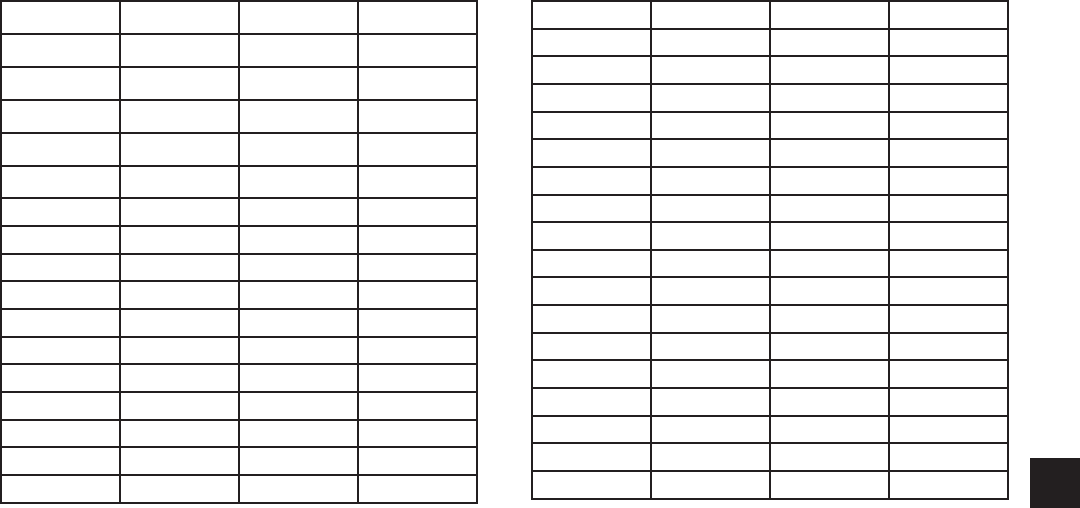
153
JOHNSON CONTROLS
FORM 100.50-NOM6 (1207)
8
ANALOG INPUT OPERATION
This section describes the control operation of the (29)
twenty-nine analog inputs. These inputs are used by
the control to monitor and respond to unit temperatures,
pressures, enthalpy, etc. The location of each of these
connections on the Unit Controller is contained in
Table 8-8. Notice that the ID gives the jack connection
designated as “J” and then the identifying number of
the connector, followed by a – and then the pin number
of the connector. For example the SUPPLY AIR
TEMPERATURE analog input would be found at J1-1.
This is connector J1 – Pin 1. As the Unit Control board
is positioned in the control box the top row of the J series
connectors is the input, the middle row is the common,
and the bottom row is the 5 VDC input to the sensor.
Also the pin in the right hand top corner is pin 1.
Temperature Sensors
The temperature sensors are all 10K Type III Thermistors.
The relationship between the temperature and the
voltage output and resistance is contained in Table 8-1
.The following analog input are of this type: Supply
Air Temperature, Heat Entering Temp, Flex Evap Temp,
Outside Air Temp, Return Air Temp, Suction Temp #1,
Suction Temp #2, Zone Temp, and Under Floor Temp.
Duct Pressure Transducer
The Duct Pressure Transducer is located behind the right
hand damper door. The purpose of the transducer is to
sense and convert the static pressure in the supply-side
of the duct to a 0 to 5 volt DC voltage. The DC voltage
is sent to the Unit Controller and compared against the
“DUCT STATIC PRESS ACTIVE SP”. The transducer is
factory wired, but pneumatic tubing must be fi eld supplied
and installed (refer to Section 2 “INSTALLATION” in this
manual). The Duct Static Pressure Transducer measures
differential pressure between the pressure in the duct
and atmospheric pressure. When verifying transducer
operation, the technician must insert a tee in the pneumatic
tubing and connect a manometer to the tee to verify the
pressure being applied to the transducer. Once this pressure
is known, a comparison can be made of the duct pressure
vs. output volts DC from the transducer. Table 8-2 shows
the relationship between the pressure applied to the duct
pressure transducer and the output voltage. The output is
linear between 0" WC and the SPAN. The “DUCT PRESS
TRANSDUCER SPAN” can be set to 1.25, 2.5 or 5" WC.
The “DUCT PRESS TRANSDUCER SPAN” must always
be set based on the span of the transducer installed.
°F VOLTAGE RESISTANCE °C
-25 0.49 139,639 -30.6
-20 0.53 127,453 -28.9
-15 0.60 109,624 -26.1
-10 0.69 94,519 -23.34
-5 0.78 81,665 -20.55
0.0 0.88 70,750 -17.78
5 0.98 61,418 -15.00
10 1.10 53,426 -12.22
15 1.22 46,582 -9.44
20 1.35 40,703 -6.67
25 1.48 35,639 -3.89
30 1.62 31,269 -1.11
35 1.77 27,490 1.67
40 1.91 24,219 4.44
45 2.06 21,377 7.22
50 2.21 18,900 10.00
TABLE 8-1 – TEMPERATURE SENSOR RESISTANCE
°F VOLTAGE RESISTANCE °C
55 2.36 16,744 12.78
60 2.51 14,681 15.56
65 2.66 13,216 18.33
70 2.80 11,771 21.11
75 2.94 10,502 23.89
80 3.08 9,388 26.67
85 3.21 8,404 29.45
90 3.33 7,537 32.22
95 3.45 6,770 35.0
100 3.56 6,090 37.78
105 3.66 5,487 40.56
110 3.76 4,951 43.34
115 3.85 4,475 46.11
120 3.94 4,050 48.89
125 4.02 3,671 51.66
130 4.09 3,332 54.44
135 4.16 3,029 57.22
SECTION 8 – SERVICE
